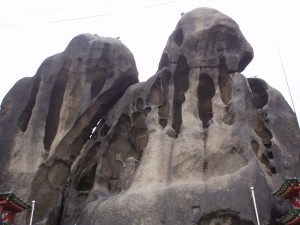To anyone living in Japan the phenomenon of iwakura and kami-inhabited rocks is very striking. I would even suggest that it’s central to Shinto. So I find the omission of discussion about iwakura in English-language material to be puzzling and paradoxical. When you find whole shrines built around a rock (Iwafune, Tenkawa and Kamikura are three of the most striking ‘iwakura jinja’ I’ve visited), then it is clear that something very special is going on. And when you find a trail of notable iwakura stretching from Tsushima island down through Kyushu, clustered around the Inland Sea, and then around the Honshu mainland, then you can see that sacred rocks are not just numerous but obviously held enormous spiritual significance for the earliest practitioners of ‘Shinto’. On top of this you have mention in Kojiki and elsewhere of kami arriving in ‘rock-boats’ from Heaven. Er…. a rock-boat???? Why would anyone choose a rock to travel in when they could choose a tree… or a flower…. or a whole island??
Despite the centrality of iwakura to the Shinto tradition, you don’t find the topic raised in Sokyo Ono’s book, which is the best-known and longest selling English language book on Shinto. You don’t find it raised in The Catalpa Bow, which is dedicated to ancient beliefs. You don’t even find it as a topic in Stuart Picken’s comprehensive and encyclopaedic Essentials of Shinto, which has 400 dense pages. The Kokugakuin online entry briefly describes rock worship but does not offer much in the way of explanation as to why or how this arose. http://eos.kokugakuin.ac.jp/modules/xwords/entry.php?entryID=251 It was while pondering such matters that one day I happened on a picture of the shaman’s rock in the middle of Lake Baikal. http://www.wildernessphotography.com/Baikal/shamanrockvera.html

Shaman's Rock in Lake Baikal
Since this is thought to be the area where Siberian shamanism arose, I was intrigued by the fact that it might offer some clues and made arrangements to travel there. Sure enough, the rock abounds with local legend to do with spirit possession. For as long back as anyone has knowledge of, the rock was treated with reverence and people passing by on horseback would get off and walk. Rituals would be held before it. There is a cave which is interesting as an opening into another ‘world’, but there is also a great sense of presence about the rock which gives one the feel of spiritual energy as Yamakage sensei puts it. Whether this accrues from the centuries of worship, from the suggestiveness of its treatment as a spiritual focus, or from genuine geomantic causes I’m unable to say…
After Siberia I travelled to Korea where there is a tradition of rock worship that if anything is even more striking. In Seoul for instance you can visit the shamanistic site of Seonbawi where you will see that the tradition is still very much alive and flourishing.

Seonbawi rock at Seoul
And I must say the spiritual energy of the rocks is very palpable. For one thing there is the haunting shape of the main rocks which look like two shadowy presences overlooking the city below: http://www.san-shin.net/Inwang-seonbawi.html
Now all this I believe is related to shamanistic practices elsewhere and the cultivation of New Age crystals etc. Also I was intrigued to read this year of a new theory about Stonehenge which suggests that the rocks from Wales mysteriously transported over hundreds of miles had special healing properties. “The bluestones were thought to have healing properties; fresh-water springs found in the same location as the bluestones were considered sacred. As recently as the 18th century, people travelled to Stonehenge for the purpose of breaking off a piece of rock to be used as a good-luck object.”

Leave a Reply